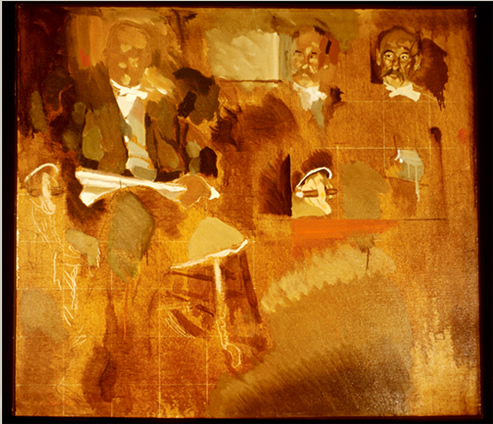David Routon
David Routon
David F. Routon was born in 1931 in Tennessee and lived there through his teen years. Like many who end up choosing visual art as a career, his interest in visual imagery emerged early. Off and on throughout his childhood and early teens he drew and painted. As a young adult he briefly experimented with other vocational options. He entertained a secondary interest in prose writing by working in journalism and explored as a possible outlet for his visual interests documentary film-making. But ultimately his vocational focus reverted to drawing and painting. He attended various colleges eventually (in 1959) to earn an undergraduate art degree, the BFA, at Mexico City College, a private English-language institution in Mexico, and (in 1963) a graduate art-practice degree, the MFA, at the University of Iowa. Thereafter, he earned his living primarily as a college art teacher. He taught at several institutions including Michigan State University, The State University College at Plattsburgh NY, the University of Minnesota in Minneapolis and, finally, the University of Nebraska in Lincoln. He retired from the University of Nebraska in 1997, and resides in Lincoln.
"I draw and paint representationally, using as my subject, for the most part, the human figure, usually clothed, and mainly the head. I have worked from both direct observation and photographs.
"Most of my work has been in the exploration of personal imagery, but a secondary involvement has been the more conventional imagery of commissioned portraiture. I enjoy rendering the straightforward realism of conventional portraiture, because I admire some of the work in the tradition of that genre. In my personal imagery, I seem to favor three subject matter sources: old photographs, the footage of motion pictures and imagery by other artists. As examples, I have made drawings and paintings derived from imagery in the 1940's spy film by Fritz Lang, The Ministry of Fear, photographs of the 19th century American New England poet, Emily Dickinson, and her associates and passages in the paintings of Gilbert Stuart, the American artist best known for his portraits of 18th century dignitaries.
"In these non-commissioned efforts I manipulate imagery with devices used by some of the American so-called 'Pop Art' painters whose works are oriented toward the figure. Such imagery varies emphasis among the different parts of a painting or drawing.
"In my pictures I explore within two sets of opposing modes. On the one hand, I aspire to firm and harmonious structure in pictorial composition while at the same time accommodating whatever emotive and psychological implications my intuition may involuntarily contribute. On the other hand, I act to make clear my work procedures by making obvious the marks in a piece — i.e. its lines or brush strokes — while simultaneously seeking a convincing illusion or representation of real-world things."







































